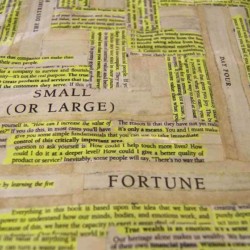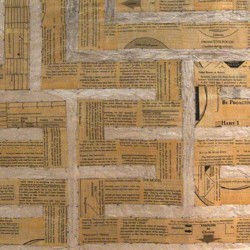7 Habits
This series of large-scale collages began with a single impulse – I wanted to try to make sense of the information in a book I was reading. Picking through the content of this particular book (The Seven Habits of Highly Effective People – a New York Times Bestseller by Stephen Covey) felt too simple – it was a 7-step process that claimed to, if followed, change your life fundamentally. This concept has bothered me since the I first acquired a copy of the book (but didn’t read it) about 7 years ago.
Cant’ Get Lost?
A labyrinth, as I understand it, is a maze in which you can’t get lost – there is a single path in, and you use the same path to get out – once you’ve reached your goal, you simply turn around and retrace your steps (remember Theseus retracing Ariadne’s golden thread?).
Labyrinths can be used to solve problems – the walker asks a question as they enter, and at each turn on the path, ponders the question from a slightly different perspective, hopefully achieving clarity by the time they’ve walked the whole maze. In essence, labyrinths are a way of going for a long, thoughtful walk in a fairly compact space.

‘7 Habits of Highly Effective People 7 Path Labyrinth’, (work in progress), book pages on paper, 163 x 163 cm, 2012
Taking a Line of Thought for a Walk
So it seemed appropriate to use a labyrinth pattern to trace the path of this ‘simple’ self-help book. I dissected the book, pulling the chapters and pages apart, sifting through the information, pulling out key sentences and the ‘nuggets’ of ‘important’ content. And then I spread out the information I’d gleaned onto the labyrinth, mapping the paths chapter by chapter, reaching the goal – the concluding chapter with the big ‘aha’ moment presumably.
Once I’d got a way into this labyrinth, I began to work on the next few in the series – more self-help or how-to books and also more maps – information is beautiful as they say. I chose a different labyrinth pattern for each map or book – from a 15th Century hedge maze pattern, to an Indian swirl labyrinth to a Greek meander. All pre-existing labyrinth patterns, not of my own design – I wanted to allow myself to be guided, both in terms of the ‘subject’ and in terms of the process itself.

‘Awaken the Giant Within’ (detail) – book pages & highlighter pen on paper, H140cm x W140cm, Dorset, 2013
Laying the Content Bare
The resulting series of 7 labyrinths seem at first glance I think quite rigid and formal – they have sharp corners and mainly straight-ish edges. However, when standing close enough to read the actual words on the page or placenames on the maps, the disjointed and fractured snippets seem a little ridiculous and nonsensical.
At the same time as taking up more space, feeling perhaps more grandiose and ‘puffed up’ than their original book or folded map format, these books have shifted or transformed in meaning also by having their contents ‘laid bare’.
- Has their original explanatory intention been increased or diminished?
- Does the viewer achieve a different understanding of them?
- How do the pathways and ‘walls’ of these new maps affect the reading of them?
What are your own first impressions?













The Series of 7 Labyrinths:
- The 7 Habits of Highly Effective People – 7-Path Labyrinth
- Herbal Labyrinth – Book Labyrinth (British Library)
- The Road to Tobermory – Scottish 7-Circuit Labyrinth
- Das Indiesche Labyrinth – Indian Labyrinth
- Awaken the Giant Within – Greco-Roman Meander
- In My Own Footsteps – Double Meander Labyrinth
- The 48 Laws of Power: 1-25 & The 48 Laws of Power: 26-48 – Triple Meander Labyrinths






















